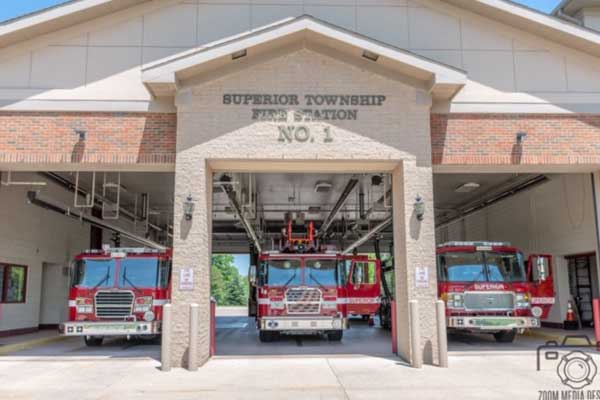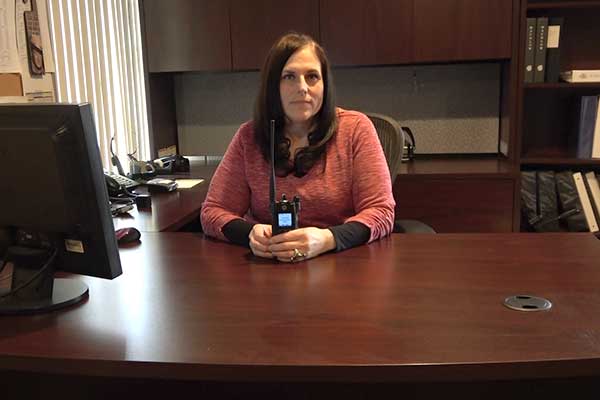The Solution
The Washtenaw County 800 MHz radio system was created in 1985 and implemented in 1987. The idea for a system with the new “trunking” technology was proposed by Bill Folsky, head of the Ann Arbor City Radio Shop, and brought to fruition by Sheriff Ron Schebil, Ann Arbor Police Chief Bill Corbett, Milan Police Chief Bill Zsenyuk, and Saline Police Chief Jim Douglas.
The first generation of the system included one 10-channel tower site located on Sunset St. in the City of Ann Arbor. Washtenaw County and the Cities of Ann Arbor, Milan, and Saline initially financed the system. Each entity paid a portion of the cost of the backbone equal to their percentage of the total radios on the system. To ensure that the original participants were not penalized financially for joining the system in the beginning, a formula for charging new users a “buy in” fee for new radios was developed. These fees were distributed back to system users based on the number of radios they maintained on the system.
During the first 10 years, the number of radios grew by about 200 percent and 3 additional frequencies were acquired for the system. The City of Ann Arbor continued to lead the organization and provided a sergeant or lieutenant as staff support. They also absorbed ancillary costs.
 In about 1993 the idea to enhance the system was put forth. To improve coverage, a three tower site system was designed and the plan was to be funded by pooling all of the new 9-1-1 surcharge funds for three years. After several unsuccessful attempts to secure tower locations, the system was finally upgraded to a two-tower system in 1998. The primary site was located on Jackson Ave. near Wagner Rd. in Scio Township and the second site was at the northwest corner of Clark Rd and Leforge Rd in Superior Township. A third site was secured at Eisenhower Blvd. and State Street in Ann Arbor, but was not completed due to the cost. All backbone equipment except the Central Electronics Bank (CEB) was replaced. The system was established as a 12-channel system because one of the original frequencies was allocated to the University of Michigan for a data system (in exchange for the rights to the third tower site). This made sense because that frequency was plagued with periodic interference that rendered it useless for voice transitions.
In about 1993 the idea to enhance the system was put forth. To improve coverage, a three tower site system was designed and the plan was to be funded by pooling all of the new 9-1-1 surcharge funds for three years. After several unsuccessful attempts to secure tower locations, the system was finally upgraded to a two-tower system in 1998. The primary site was located on Jackson Ave. near Wagner Rd. in Scio Township and the second site was at the northwest corner of Clark Rd and Leforge Rd in Superior Township. A third site was secured at Eisenhower Blvd. and State Street in Ann Arbor, but was not completed due to the cost. All backbone equipment except the Central Electronics Bank (CEB) was replaced. The system was established as a 12-channel system because one of the original frequencies was allocated to the University of Michigan for a data system (in exchange for the rights to the third tower site). This made sense because that frequency was plagued with periodic interference that rendered it useless for voice transitions.
The relationship with the University of Michigan started in about 1989 when a trunked Motorola 800 MHz system was installed on campus. This system was completely independent from the countywide system. That independence was used to our advantage when the consortium entered into an agreement with the University to exchange backup talkgroup IDs. Each radio in the countywide system was programmed with a talkgroup on the University system to be used as a backup in the case of catastrophic system failure. The University did the same, and this relationship and backup system design continues to this day.
In 2002, Ann Arbor Police Chief Dan Oates started to put forth the idea of a truly interoperable radio system in Washtenaw County to serve all first responders. Chief Oates had joined the AAPD in August of 2001 after retiring as a Deputy Chief of the New York Police Department. Interoperability was a concept enhanced by the tragedy of 9-11, and Chief Oates used his passion over the attack on New York and the loss of former colleagues, to advocate for a county-wide millage to fund good, interoperable communications for all police, fire and EMS units in Washtenaw County. He chaired a working group to investigate the possibility of a county-wide emergency communications millage. The group was a grassroots public safety effort that was support by all the chiefs in the county.
When Chief Oates left Ann Arbor for a job as police chief in Aurora, Colorado, he asked Saline Police Chief Paul Bunten to take over the leadership role. Chief Bunten and the working groups were able to make the case for an enhanced communications system. They cultivated support within the community, and the Board of Commissioners placed the Emergency Communications Millage on the ballot in 2005. It passed with sixty-three percent of the vote.
Once the millage was approved, the Board of Commissioners create the Project Oversight Committee (POC), a five member board charged with authorizing the disbursement of the millage funds. The POC included the County Administrator, the County Finance Director, and one representative each from police, fire, and EMS. The original members were County Administrator Bob Guenzel, County Finance Director Pete Ballios, Saline Police Chief Paul Bunten, Pittsfield Township Fire Chief Al D’Agostino, and Huron Valley Ambulance Vice President Jerry Zapolnic.
 The POC created the Project Implementation Team (PIT) to investigate communications options and to make recommendations about the system implementation. This group was chaired by Deputy Chief Jack Ceo of the Saline Police Department. The team included representatives from police, fire, EMS, dispatch, and Emergency Management. The PIT evaluated several options for communications and determined that joining the Michigan Public Safety Communications System (MPSCS) was the best option for Washtenaw County. In 2008, Washtenaw County signed a contract with Motorola Solutions to build six new tower sites in the county. The MPSCS provide their Baker Road tower site to the subsystem, and coverage within the county was increase to 95% in building at db 3.4 or greater. In August of 2010, the system went live, and within six months all police, fire, and EMS units were using the system.
The POC created the Project Implementation Team (PIT) to investigate communications options and to make recommendations about the system implementation. This group was chaired by Deputy Chief Jack Ceo of the Saline Police Department. The team included representatives from police, fire, EMS, dispatch, and Emergency Management. The PIT evaluated several options for communications and determined that joining the Michigan Public Safety Communications System (MPSCS) was the best option for Washtenaw County. In 2008, Washtenaw County signed a contract with Motorola Solutions to build six new tower sites in the county. The MPSCS provide their Baker Road tower site to the subsystem, and coverage within the county was increase to 95% in building at db 3.4 or greater. In August of 2010, the system went live, and within six months all police, fire, and EMS units were using the system.
Soon after the voice system was implemented, the fire service requested that the VHF paging system throughout the county be enhanced. The POC authorized funding to add the paging system to five of the MPSCS towers, to provide simulcast paging throughout the county. This replaced individual towers and phone lines that were used in Augusta, Manchester, Scio, and Salem. Unfortunately, soon after implementation, the FCC mandated narrow banding of the VHF frequencies was implemented, and system cover was reduced to an unacceptable level. To remedy this issue, the POC authorized moving emergency notification paging from VHF to the new 800 MHz paging on the MPSCS system. Every fire department that was using pagers was provided with Unication pagers, and eventually station alerting was also moved to 800 MHz.
In 2015, the Washtenaw County Board of Commissioners placed the millage on the ballot for renewal. An information campaign was again organized, and in addition to maintaining the interoperable radios system, the new funding proposed the deployment of a Next Generation 9-1-1 system. This would mean the ability to text to 9-1-1 (call when you can, text if you can’t), and when available from the cellular companies, a platform for sending pictures, video, and telematics information to 9-1-1. Telematics includes such things as automatic crash notification from sensors in vehicles and medical alerts from implanted and body worn devices. The millage was support by 74% of the voters.






 In about 1993 the idea to enhance the system was put forth. To improve coverage, a three tower site system was designed and the plan was to be funded by pooling all of the new 9-1-1 surcharge funds for three years. After several unsuccessful attempts to secure tower locations, the system was finally upgraded to a two-tower system in 1998. The primary site was located on Jackson Ave. near Wagner Rd. in Scio Township and the second site was at the northwest corner of Clark Rd and Leforge Rd in Superior Township. A third site was secured at Eisenhower Blvd. and State Street in Ann Arbor, but was not completed due to the cost. All backbone equipment except the Central Electronics Bank (CEB) was replaced. The system was established as a 12-channel system because one of the original frequencies was allocated to the University of Michigan for a data system (in exchange for the rights to the third tower site). This made sense because that frequency was plagued with periodic interference that rendered it useless for voice transitions.
In about 1993 the idea to enhance the system was put forth. To improve coverage, a three tower site system was designed and the plan was to be funded by pooling all of the new 9-1-1 surcharge funds for three years. After several unsuccessful attempts to secure tower locations, the system was finally upgraded to a two-tower system in 1998. The primary site was located on Jackson Ave. near Wagner Rd. in Scio Township and the second site was at the northwest corner of Clark Rd and Leforge Rd in Superior Township. A third site was secured at Eisenhower Blvd. and State Street in Ann Arbor, but was not completed due to the cost. All backbone equipment except the Central Electronics Bank (CEB) was replaced. The system was established as a 12-channel system because one of the original frequencies was allocated to the University of Michigan for a data system (in exchange for the rights to the third tower site). This made sense because that frequency was plagued with periodic interference that rendered it useless for voice transitions. The POC created the Project Implementation Team (PIT) to investigate communications options and to make recommendations about the system implementation. This group was chaired by Deputy Chief Jack Ceo of the Saline Police Department. The team included representatives from police, fire, EMS, dispatch, and Emergency Management. The PIT evaluated several options for communications and determined that joining the Michigan Public Safety Communications System (MPSCS) was the best option for Washtenaw County. In 2008, Washtenaw County signed a contract with Motorola Solutions to build six new tower sites in the county. The MPSCS provide their Baker Road tower site to the subsystem, and coverage within the county was increase to 95% in building at db 3.4 or greater. In August of 2010, the system went live, and within six months all police, fire, and EMS units were using the system.
The POC created the Project Implementation Team (PIT) to investigate communications options and to make recommendations about the system implementation. This group was chaired by Deputy Chief Jack Ceo of the Saline Police Department. The team included representatives from police, fire, EMS, dispatch, and Emergency Management. The PIT evaluated several options for communications and determined that joining the Michigan Public Safety Communications System (MPSCS) was the best option for Washtenaw County. In 2008, Washtenaw County signed a contract with Motorola Solutions to build six new tower sites in the county. The MPSCS provide their Baker Road tower site to the subsystem, and coverage within the county was increase to 95% in building at db 3.4 or greater. In August of 2010, the system went live, and within six months all police, fire, and EMS units were using the system.